Neuroprotective effect of menaquinone-4 (MK-4) on transient global cerebral ischemia/reperfusion injury in rat
- PMID: 32150581
- PMCID: PMC7062268
- DOI: 10.1371/journal.pone.0229769
Neuroprotective effect of menaquinone-4 (MK-4) on transient global cerebral ischemia/reperfusion injury in rat
Abstract
Cerebral ischemia/reperfusion (I/R) injury causes cognitive deficits, excitotoxicity, neuroinflammation, oxidative stress and brain edema. Vitamin K2 (Menaquinone 4, MK-4) as a potent antioxidant can be a good candidate to ameliorate I/R consequences. This study focused on the neuroprotective effects of MK-4 for cerebral I/R insult in rat's hippocampus. The rat model of cerebral I/R was generated by transient bilateral common carotid artery occlusion for 20 min. Rats were divided into control, I/R, I/R+DMSO (solvent (1% v/v)) and I/R+MK-4 treated (400 mg/kg, i.p.) groups. Twenty-four hours after I/R injury induction, total brain water content, superoxide dismutase (SOD) activity, nitrate/nitrite concentration and neuronal density were evaluated. In addition to quantify the apoptosis processes, TUNEL staining, as well as expression level of Bax and Bcl2, were assessed. To evaluate astrogliosis and induced neurotoxicity by I/R GFAP and GLT-1 mRNA expression level were quantified. Furthermore, pro-inflammatory cytokines including IL-1β, IL-6 and TNF-α were measured. Seven days post I/R, behavioral analysis to quantify cognitive function, as well as Nissl staining for surviving neuronal evaluation, were conducted. The findings indicated that administration of MK-4 following I/R injury improved anxiety-like behavior, short term and spatial learning and memory impairment induced by I/R. Also, MK-4 was able to diminish the increased total brain water content, apoptotic cell density, Bax/ Bcl2 ratio and GFAP mRNA expression following I/R. In addition, the high level of nitrate/nitrite, IL-6, IL-1β and TNF-α induced by I/R was reduced after MK-4 administration. However, MK-4 promotes the level of SOD activity and GLT-1 mRNA expression in I/R rat model. The findings demonstrated that MK-4 can rescue transient global cerebral I/R consequences via its anti-inflammatory and anti-oxidative stress features. MK-4 administration ameliorates neuroinflammation, neurotoxicity and neuronal cell death processes and leads to neuroprotection.
Conflict of interest statement
The authors have declared that no competing interests exist.
Figures


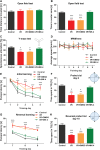


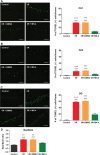
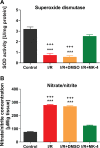
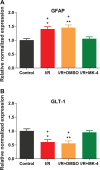
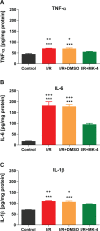
Similar articles
-
Ethyl-acetate fraction of Trichilia catigua protects against oxidative stress and neuroinflammation after cerebral ischemia/reperfusion.J Ethnopharmacol. 2018 Jul 15;221:109-118. doi: 10.1016/j.jep.2018.04.018. Epub 2018 Apr 13. J Ethnopharmacol. 2018. PMID: 29660468
-
Bavachinin attenuates cerebral ischemia/reperfusion injury in rats via its anti-inflammatory and antioxidant effects.Tissue Cell. 2025 Aug;95:102886. doi: 10.1016/j.tice.2025.102886. Epub 2025 Mar 28. Tissue Cell. 2025. PMID: 40164017
-
Neuroprotective effect of minocycline on cognitive impairments induced by transient cerebral ischemia/reperfusion through its anti-inflammatory and anti-oxidant properties in male rat.Brain Res Bull. 2017 May;131:207-213. doi: 10.1016/j.brainresbull.2017.04.010. Epub 2017 Apr 25. Brain Res Bull. 2017. PMID: 28454931
-
Chemical characterization and cerebroprotective effect of methanolic root extract of Colebrookea oppositifolia in rats.J Ethnopharmacol. 2018 Sep 15;223:63-75. doi: 10.1016/j.jep.2018.05.009. Epub 2018 May 16. J Ethnopharmacol. 2018. PMID: 29777902
-
Protective effects of sevoflurane in cerebral ischemia reperfusion injury: a narrative review.Med Gas Res. 2021 Oct-Dec;11(4):152-154. doi: 10.4103/2045-9912.318860. Med Gas Res. 2021. PMID: 34213497 Free PMC article. Review.
Cited by
-
Astaxanthin Modulates Autophagy, Apoptosis, and Neuronal Oxidative Stress in a Rat Model of Compression Spinal Cord Injury.Neurochem Res. 2022 Jul;47(7):2043-2051. doi: 10.1007/s11064-022-03593-1. Epub 2022 Apr 18. Neurochem Res. 2022. PMID: 35435619
-
Pioglitazone Ameliorates Renal Ischemia-Reperfusion Injury via Inhibition of NF-κB Activation and Inflammation in Rats.Front Physiol. 2021 Jul 19;12:707344. doi: 10.3389/fphys.2021.707344. eCollection 2021. Front Physiol. 2021. PMID: 34349671 Free PMC article.
-
Vitamin K Properties in Stroke and Alzheimer's Disease: A Janus Bifrons in Protection and Prevention.Molecules. 2025 Feb 24;30(5):1027. doi: 10.3390/molecules30051027. Molecules. 2025. PMID: 40076254 Free PMC article. Review.
-
Naphthoquinones as a Promising Class of Compounds for Facing the Challenge of Parkinson's Disease.Pharmaceuticals (Basel). 2023 Nov 8;16(11):1577. doi: 10.3390/ph16111577. Pharmaceuticals (Basel). 2023. PMID: 38004442 Free PMC article. Review.
-
Neuroprotective Effects of Aucubin against Cerebral Ischemia and Ischemia Injury through the Inhibition of the TLR4/NF-κB Inflammatory Signaling Pathway in Gerbils.Int J Mol Sci. 2024 Mar 19;25(6):3461. doi: 10.3390/ijms25063461. Int J Mol Sci. 2024. PMID: 38542434 Free PMC article.
References
-
- Ma J, Liu Z, Shi Z. Oxidative Stress and Nitric Oxide in Cerebral Ischemic Reperfusion Injury Cerebral Ischemic Reperfusion Injuries (CIRI): Springer; 2018. p. 101–19.
Publication types
MeSH terms
Substances
LinkOut - more resources
Full Text Sources
Other Literature Sources
Research Materials
Miscellaneous

